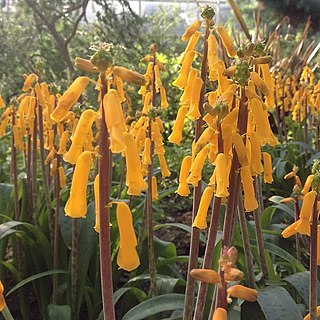
The Asclepiadoideae are a subfamily of plants in the family Apocynaceae. Formerly, it was treated as a separate family under the name Asclepiadaceae, e.g. by APG II, and known as the milkweed family.

Cynanchum is a genus of about 300 species including some swallowworts, belonging to the family Apocynaceae. The taxon name comes from Greek kynos and anchein, hence the common name for several species is dog-strangling vine. Most species are non-succulent climbers or twiners. There is some evidence of toxicity.

Encyclia is a genus of orchids. The genus name comes from Greek enkykleomai, referring to the lateral lobes of the lip which encircle the column. It is abbreviated as E. in the horticultural trade.

Laeliinae is a Neotropical subtribe including 40 orchid genera, such as Brassavola, Laelia and Cattleya. The genus Epidendrum is the largest within this subtribe, containing about 1500 species. This is followed by the genus Encyclia, with over 120 species.

Lachenalia is a genus of bulbous perennial plants in the family Asparagaceae, subfamily Scilloideae, which are usually found in Namibia and South Africa. Most of them have a dormancy period, but new roots will always grow every year.

Epidendrum secundum, one of the crucifix orchids, is a poorly understood reed stemmed species, which Dressler (1989) describes as "the Epidendrum secundum complex." According to Dressler, there are dozens of varieties, some of which appear to deserve species rank. Arditti and Ghani note that E. secundum has the distinction of bearing the longest seeds known in the Orchidaceae, 6.0 mm long. By comparison, the seeds of E. ibaguense are only 2.9 mm long.

Encyclia adenocaula is a species of epiphytic orchid of light purple flowers, native to forests in Mexico.
Epidendrum verrucosum is a species of Epidendrum orchid that was described by Schwartz in 1806. In 1861, Reichenbach placed it in subsection Euepidendrum Planifolia Paniculata of the genus Epidendrum.

Encyclia alata is a species of orchid native from south Mexico through Central America to Panama.

Encyclia ambigua is a species of orchid native to Guatemala and southeast Mexico.
Encyclia trachychila is a species of flowering plant in the family Orchidaceae, native to El Salvador, Guatemala, Honduras, and Nicaragua. It was first described in 1853 as Epidendrum trachychilum.

Encyclia ceratistes, also known as Epidendrum ramonense or frosted rain, is a species of orchid. It is found in southeast and southwest Mexico, Central America and the northern parts of South America. E. ceratistes prefers hot-to-cool oak and mixed hardwood forests at 330 to 1600 m in elevation.
Epidendrum amictumLinden & Rchb.f., synonym Encyclia amicta(Linden & Rchb.f.) Schltr., is an "unplaced" species of orchid according to Plants of the World Online, as of December 2023.

Epidendrum ibaguense is a species of epiphytic orchid of the genus Epidendrum which occurs in Trinidad, French Guiana, Venezuela, Colombia and Northern Brazil.

Polystachya concreta, the greater yellowspike orchid, is a species of orchid native to tropical and subtropical America, Africa and Asia.

Funastrum is a genus of flowering plant now in the family Apocynaceae. The name is derived from the Latin word funis, meaning "rope", and astrum, alluding to the twining stems. Members of the genus are commonly known as twinevines.
Alex Drum Hawkes (1927–1977) was an American botanist and cookbook author who lived in Coconut Grove, Florida & Kingston, Jamaica. Alex specialized in orchids, bromeliads, palm trees, fruits, vegetables, and nuts. Named the orchid genera Flickingeria, and Paraphalaenopsis and travelled the world extensively, particularly the Caribbean & Latin America during the 1940s - 1970s collecting plants and authentic regional recipes.











